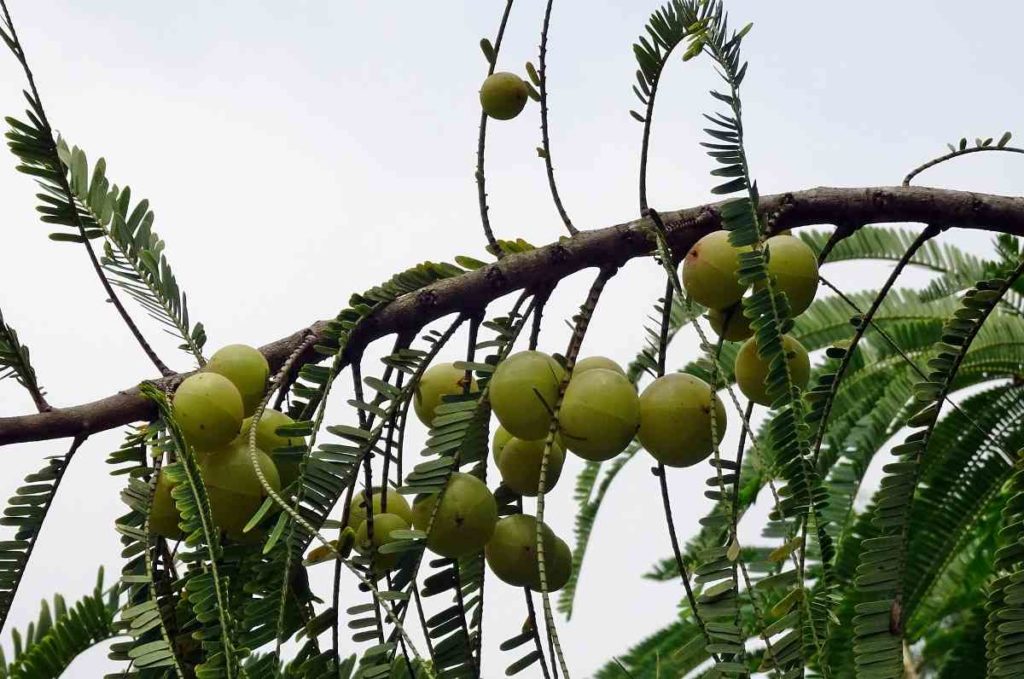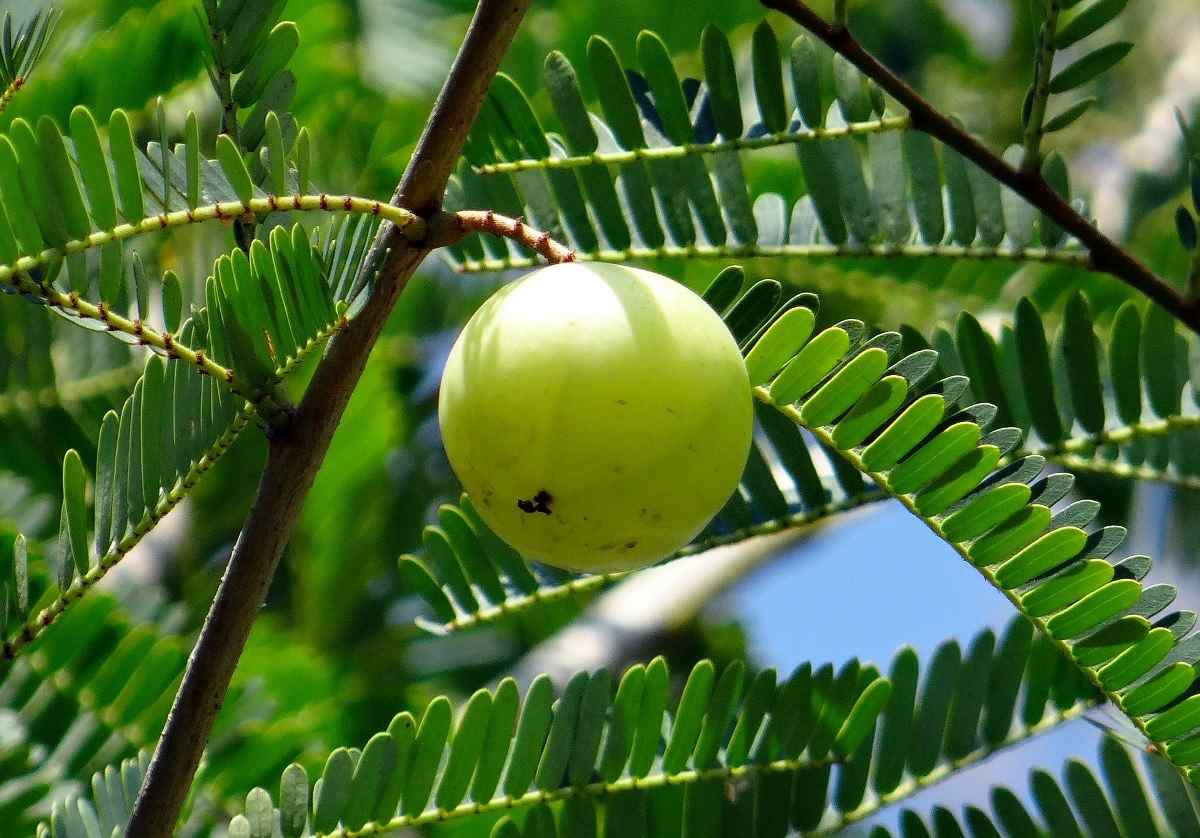Growing Amla at Home for Beginners
Here, today we are going to discuss growing Amla at home (Indian Gooseberry).
Introduction to Growing Amla at home
Amla is also known as Indian Gooseberry. Amla is an important plant in Ayurveda. They have the richest source of vitamin-C. It is vertical striped, round-shaped in structure. It is greenish-yellow in color and features a sour taste. Due to its sour taste, is mostly used in the preparation of pickles and with other ingredients. It is an important tropical plant with high medical value. The skin is tough, but the crisp flesh. The fruit has high antioxidant content. This fruit can be eaten fresh, though it tastes sour. It has many health benefits. Dried and powdered Amla powder can be sprinkled on fruits.
Topics going to cover in this article;
- Varieties of Amla in India.
- Soil conditions for Amla.
- Climatic conditions for Amla.
- Propagation of Amla.
- How to plant Amla?
- Growing Amla from seeds.
- Water requirement for Amla.
- Position to be placed.
- Pruning of Amla tree.
- Training of Amla tree.
- Mulching.
- Pests and diseases of Amla.
- How to protect from pests and diseases?
- How to induce flowering in Amla?
- Amla tree growing time.
A Step-by-Step Guide to Growing Amla at Home in India
Varieties for Growing Amla at Home in India
There are mainly four types. They are;
- Banarasi– This variety matures earlier than other varieties. But they have a short shelf life. It is not used much for culinary purposes.
- Chakaiya-It yields heavily every year and has smaller fruits compared to all other varieties. They are used in making candies
- Francis– They gives high yield and in the manufacture of Amla based products.
- Wild Himalayan Amla– It is a special variety of Amla that is adapted to cold temperatures also.
The other varieties are;
- NA-4 (Krishna),
- NA-5 (Kanchan),
- NA-6,
- NA-7 (Promising variety),
- NA-10,
- BSR-1 (Bhavanisagar).
Soil Conditions for Growing Amla at Home
Light and medium-heavy soils except purely sandy soil are ideal for Amla plantation. The tree is well adapted to dry regions and may even be grown in moderate alkaline soils. Owing to its hardy nature it’s grown in a sort of soils. It has grown in slightly acidic to saline soils and may be grown in calcareous soil. It gives the best result when grown under fertile-loamy soil with a good system. It also can tolerate moderate alkaline soil. It requires the pH of soil ranging from 6.5-9.5. Avoid cultivation in heavy soils.
Climatic Conditions for Growing Amla at Home
- How to Grow Tomatoes Organically at Home: A Comprehensive Guide
- Organic Gardening on a Budget: Low-Cost Methods and Materials
- Gongura Seed Germination and Planting Methods
- Cabbage Seed Germination and Selection
- Broccoli Seed Germination and Selection
- Asparagus Seed Germination and Variety Selection

It is a tropical plant. Annual rainfall of 630-800 mm is right for its growth. The young plant up to the age of three years should be shielded from hot wind during May-June and frost during the winter months. The mature plants can tolerate freezing temperatures also as a heat up to 46 degrees C.
Propagation for Growing Amla at Home
Amla is commonly propagated through seeds, but seed propagated trees bear quality fruits and have an extended gestation. Shield budding is completed on one-year-old seedlings with buds collected from superior strains yielding big size fruits. Older trees of inferior types are often rejuvenated and simply become superior types by top working.
How to Plant Amla?
The pits of a 1meter cube are prepared during May-June at a distance of 4.5 m spacing and will be left for 15-20 days exposed to sunlight. Each pit should be crammed with topsoil mixed with 15 kg farmyard manure (FYM) and one kg of superphosphate before planting the grafted seedling.
Growing Amla at Home from Seeds
Growing Amla from seed is a very slow process but growing a tree from seeds is a tricky thing to do
- Take Amla seeds. Make sure there is no flesh left.
- Dry the seeds for a minimum of 48 hours.
- After drying, soak the seeds in water for 24 hours.
- If you find any seeds floating up in the water then remove them. These will not germinate.
- Then grab around 4 seeds of Amla and place them in a paper towel and roll it up.
- Spray water on the paper towel. Just enough to soak the tissue.
- Put them into a zip lock bag and seal them properly.
- Label it with the date and keep it in a dry place.
- Check after 7 days and you will see sprouting. Then move the seedling to your desired place.
Water Requirement for Growing Amla at Home
Amla plants hardly require more water during monsoon. Young plants require watering during the summer months at 15 days intervals till they need fully established. Watering of mature fruit-bearing plants is suggested during summer months at bi-weekly intervals to extend fruit set and to reduce fruit drop. It responds alright to drip irrigation. After the monsoon rains, during October and December, about 25-30 liters of water per day per tree through drips should tend for the Amla plant.
Amla Plant Position to be placed
Plant Amla in a location where there is less windy and sunny. The well-draining and sloppy positions are better for their growth.
Pruning of Amla Tree
It is better to leave only 4-5 well-shaped branches with the best angle at about 0.75 m from the bottom level, other dead, diseased, week crisscrossing branches and suckers should be pruned off at the top of December. Then the development of the Amla tree will be amazing.
Training to Amla Tree
The main branches should be allowed to seem at a height of 0.75-1 m above the bottom level. Plants should be trained to modify the central leader system. Two to four branches with wide crotch angle, appearing within the opposite directions should be encouraged in the early years.
Mulching Requirement for Growing Amla at Home
Do thick mulching with any organic matter at the top of the spring to assist the substrate in retaining moisture.
In case if you miss this: Growing Plants in Grow Bags.
Pests and Diseases of Amla
Insect pests are;
- Bark eating caterpillar
Favorable conditions – Attacks in April at the initiation of new growth.
Symptoms- Make tunnels in the main branches and trunk.
- Apical twig gall maker
The favorable condition is the rainy season.
Symptoms- Terminal shoots swell.
Attacks during monsoon season on the onset of new growth.
- Aphids
Favorable condition- These pests are mainly seen from July to October with a peak period in September.
Symptoms- Yellowing the flowers with honeydew.
- Mealybug
Favorable condition- Moist and warm conditions are more favorable for natural enemies of bugs.
Symptoms- Premature shedding of fruits and yellowing of flowers.
- Whiteflies
Favorable conditions mainly in warm conditions.
Symptoms- Leaf turns pinkish or purple then later leaves may dry out.
- Anar butterfly
Favorable conditions- Mainly during September and October.
Symptoms- The extraction of larva around the entry holes are seen.
- Leaf miner
Favorable conditions- Mostly favor moist conditions.
Symptoms- Newly emerged leaves are preferred for feeding sites.
Diseases are;
- Rust
Favorable conditions- After monsoon in September.
Symptoms- On Fruits Few Black Pustules Appear That Later Develop Into A Ring.
- Soft rot
Favorable conditions- Hot and wet weather.
Symptoms- smoke brown round lesions appear on the fruit.
- Nutritional disorder
Favorable conditions- Second and third week of September.
Symptoms- Internal in Amla fruit is caused by a boron deficiency.
How to Protect From Pests and Diseases?
- For protecting the tree from bark eating caterpillar inject 0.05% of Endosulphon or Monocrotophos 0.03% in holes and plugging with mud is more effective.
- In the first early September spraying of 0.03% of Indofil M-45 and the second 15 days after the first application controls the spread of rust in the Amla tree.
How to Induce Flowering in Amla?
This tree is extremely common throughout tropical and subtropical parts of India, normally the plant should start fruiting by 4-5 years, and its flowers during the months of March-April. As far as my observation cares it grows well in regions where there’s good organic matter content in soil and therefore the annual rainfall is more than 700 mm once a year. Since these plants are produced by budding the interior factors like meristem size and external factors like photoperiod, water availability, C: N ratio of soils should be checked. a perfect situation should be checking all those parameters concerning two treatments like flowering versus non-flowering.
Amla Tree Growing Time

Growing an Amla tree from seed takes around five years to supply fruits. Fruits are hard and glossy, of lifeless green color and usually appear from January to March in the tropics. The mature fruits are hard and that they don’t fall at gentle touch and thus vigorous shaking is required. Fruits also can be harvested using long bamboo poles attached with hooks.
Amla Uses and Benefits
Well, Amla is one of best fruits has excellent uses and benefits. Some of them are given below;
- Amla fruits are rich in antioxidants, can be consumed via powder or juice for better immune power.
- Amla is good for skin and hair
- Amla has a good fiber content
- Amla is good for diabetics
- Amal is good for heart health
Very good article. I am benefitted by the article in all respects especially pruning and trailing my Amla plant in my Garden. You may please mention the cell number of the author.
Amla is also known as Indian Gooseberry. Amla is an important plant in Ayurveda. They have the richest source of vitamin-C.• Thanks for the great content sir. I will also share this article with my friends & once again thanks a lots